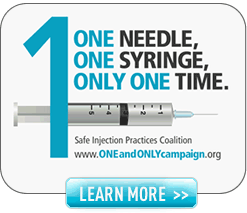HONOReform is proud to reprint board member Pam Demski-Hart’s recent contribution to the CDC’s Safe Healthcare blog. Pam is the principal and founder of Healthcare Accreditation Resources LLC, a consulting service for ambulatory healthcare and dental facilities. Following is part two of a blog series recounting her personal observations of unsafe injection practices in healthcare settings. Pamela asks, “How do we get every healthcare worker on the same page when it comes to infection control practices?”
In my last blog post, I discussed the differences between reality and perception when it comes to what safe injection/infection control practices are — and are not.
So, how do we get every healthcare worker on the same page when it comes to reinforcing correct procedures? Especially when some healthcare workers are in a sort of denial that unsafe practices actually do happen. Or, worse yet, when they are absolutely convinced they are doing the right thing when, in fact, they couldn’t be more wrong.
It’s my belief that this problem could be addressed by requiring competencies. In other words, instituting a written test or requiring administrators/trainers to observe practices at a facility. It could start with something as simple as, “Tell me about safe injection practices. Walk me through your procedure for preparing, administering, and disposing of a needle and syringe.”
That’s where the gaps in learning and knowledge may become apparent.
Why not make such a test a component of the healthcare worker’s job performance at an annual review? Key competencies should be assessed through a written exam, peer review, and/or observation. It is my belief continuing education credits do not suffice as a barometer for competency of an individual, however, they are accepted for most healthcare professionals.
Many CDC documented incidents of unsafe injection practices have occurred at outpatient practices, and there has been an explosion in the growth of these settings in recent years. It is estimated that up to 70% of surgeries take place in an outpatient setting. But I wonder, how regularly do outpatient settings have staff meetings? How often are demonstrations of competency documented on an annual basis? How many states require accreditation for these kinds of settings?
Administration must also set an example by accepting no less than 100% adherence to safe injection practices, and establishing job consequences for failure to follow safe practices. Yes, there will be a written warning in your file for failure to follow protocol.
Recently, a nurse had set up a system of monitoring data after an incident in her facility. When I visited the facility three months later, I was informed they had abandoned data collection after two months. When asked why, she responded, “We didn’t think we had a problem anymore.”
Clearly she didn’t understand the need for constant vigilance. I asked, “Would you take vital signs post-surgery at 15 minutes and at one half hour? And then when the patient seemed OK at those two intervals, just stop observing and recording based on a few ‘normal’ results?”
Learn to know what you don’t know and always ask if you’re unsure.


